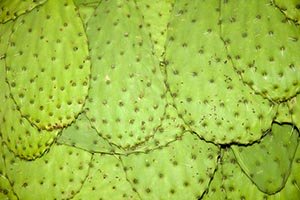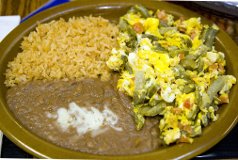Nopales (Cactus) Nutrition facts
nopalitos, have been a staple in Mexican cuisine since ancient times and are now gaining popularity among Europeans and Americans for their health benefits.
The cactus species is believed to have originated in the desert lands of Mexico. Over two hundred cultivars of the Cactaceae family grow in their natural habitat, particularly in the semi-arid and dry areas of northern Mexico. However, edible cactus paddles are primarily gathered from Opuntia ficus-indica (Barbary fig) plants.
 |
| Nopales. Note for spines on the surface. (Photo courtesy: Paul and Jill) |
Cacti are adapted evergreen plants thriving in semi-arid and desert environments. Despite being often mistaken for leaves, their flat, oval, and pad-shaped structures are actually modified stems.
These segmented stems of the cactus grow at odd angles directly from the root, forming a stacked arrangement. While in the wild they can reach heights of 10-12 feet, cultivated varieties typically grow to about 4-5 feet to manage their harvest. The surface of the nopal pads is adorned with sharp spines, known as glochids, found at the nodes.
In spring, vibrant blooms grace the sides of the pads, eventually transforming into delectable pear-shaped fruits known as "prickly pear (cactus fruits)" or commonly referred to as "tuna" throughout the Latin world. These berries typically measure around 5 cm in diameter and weigh approximately 75-100 g. Sweet and juicy, their flavor evokes a blend reminiscent of watermelon and strawberry.
Health benefits of Nopales
Nopales are exceptionally low-calorie vegetables, with just 16 calories in every 100 grams of fresh leaves. Despite their low calorie count, these modified leaves, or paddles, are packed with essential phytochemicals, fiber, antioxidants, vitamins, and minerals that contribute significantly to overall health.
The succulent paddles are particularly rich in dietary fiber, including non-carbohydrate polysaccharides like pectin, mucilage, and hemicellulose. This combination aids in weight management, lowering LDL-cholesterol, and regulating blood sugar levels. Additionally, the fiber and mucilaginous properties of cactus help alleviate constipation issues by promoting smooth digestion.
Furthermore, nopal juice has been noted for its potential immune-boosting and anti-inflammatory properties.
Cactus pads also boast moderate levels of vitamin A, with 100 grams of fresh pads providing approximately 457 IU of vitamin-A and 250 µg of ß-carotene, which converts to vitamin A in the body. Studies have shown that vitamin A and flavonoids found in vegetables offer protection against skin, lung, and oral cavity cancers.
Additionally, nopales contain a range of B-complex vitamins, including thiamin, riboflavin, niacin, vitamin B-6 (pyridoxine), and pantothenic acid, which are essential for optimal cellular enzymatic and metabolic functions.
In terms of vitamin C content, fresh pads provide an average level, with 100 grams supplying 9.3 mg or 15% of the recommended daily intake. Vitamin C acts as a water-soluble antioxidant, aiding in protection against scurvy, bolstering immunity, and scavenging harmful free radicals from the body.
Moreover, nopales contain modest amounts of minerals such as calcium, potassium, magnesium, and iron, further contributing to their nutritional value.
| Principle | Nutrient Value | Percent of RDA |
|---|---|---|
| Energy | 16 Kcal | <1% |
| Carbohydrates | 3.33 g | 2.56% |
| Protein | 1.32 g | 2% |
| Total Fat | 0.09 g | <1% |
| Cholesterol | 0 mg | 0% |
| Dietary Fiber | 2.2 g | 5.5% |
| Vitamins | ||
| Folates | 3 µg | <1% |
| Niacin | 0.410 mg | 2.5% |
| Pantothenic acid | 0.167 mg | 3% |
| Pyridoxine | 0.070 mg | 6% |
| Riboflavin | 0.041 mg | 3% |
| Thiamin | 0.012 mg | 1% |
| Vitamin C | 9.3 mg | 15.5% |
| Vitamin A | 457 IU | 15% |
| Vitamin E | 0.00 mg | 0% |
| Vitamin K | 5.3 µg | 4.4% |
| Electrolytes | ||
| Sodium | 21 mg | 1.5% |
| Potassium | 257 mg | 5.4% |
| Minerals | ||
| Calcium | 164 mg | 16% |
| Copper | 0.052 mg | 6% |
| Iron | 0.59 mg | 7% |
| Magnesium | 52 mg | 13% |
| Manganese | 0.457 mg | 20% |
| Phosphorus | 16 mg | 3% |
| Selenium | 0.7 µg | 1% |
| Zinc | 0.21 mg | 5% |
| Phyto-nutrients | ||
| Carotene-ß | 250 µg | |
| Carotene-α | 48 µg | |
| Lutein-zeaxanthin | 0 µg |
Selection and storage
In Mexico, young, tender, and succulent cactus paddles are typically harvested during the spring season for local consumption and export to Europe and the USA. Fresh nopales are commonly found in the southern US states where there are sizable Mexican communities, and canned nopalitos in brine are also available in grocery stores.
For the freshest options, visit farmer's markets specializing in Mexican vegetables to purchase fresh, firm, pale green nopal pads. It's advisable to avoid thick, mature pads as they tend to be rough, pithy, and lacking in flavor.
Once brought home, raw pads can be stored in the refrigerator for approximately a week. Diced or cut pads should be used promptly for best results.
Preparation and serving methods
Nopales, whether fresh or preserved, hold a significant place in traditional Mexican cuisine, particularly during lean days.
To prepare, hold the pad at its base and gently scrape off all the spines and bristles on either side using a blunt knife. Rinse under cold water and pat dry with a soft cloth. Next, using a vegetable peeler, remove any excess skin at the nodules. Cut into small cubes or uniform strips (known as nopaliots) according to preference. Alternatively, pre-prepared diced nopales or nopales strips are available in stores.
The flavor of fresh nopales presents a blend reminiscent of asparagus and french beans; in addition to having a chewy texture.
Here are some serving tips:

|
| Mexican nopales dish. Note cactus strips mixed with scrambled egg. (Photo: pointnshoot) |
Nopales can be enjoyed raw in salads, known as Ensalada di nopales, or in salsa, referred to as Nopal de salsa, paired with onion, tomato, seasoned with salt, pepper, dried oregano, and dressed with olive oil.
Fresh nopal is a versatile ingredient used in soups, stews, juices, and as a cooked vegetable.
Nopalitos can be fried into strips for a crispy treat.
Boiled, roasted, or grilled nopalitos make a delicious side dish.
Pickled nopal is a popular appetizer. Diced nopalitos, onion, and tomato sautéed with scrambled eggs are a favorite breakfast option during the Lent season in Mexico.
Industrially produced cactus pad (nopal) juice has been marketed as a wellness drink due to its perceived health benefits. However, scientific validation for such claims is currently lacking.
Safety profile
For centuries, native Mexicans have incorporated cactus paddles into their regular diet safely. Allergic reactions to cactus are relatively uncommon; nevertheless, individuals with known cactus allergies should refrain from consuming them altogether.
Farmers involved in harvesting spiny cacti may encounter pricks, scratches, and bruises, thus it is advisable for them to wear protective gloves and attire to minimize risks (Medical disclaimer).
You may also like yo read:-≻≻-Read Prickly pear (tuna) nutrition facts and health benefits.
≻≻-Back to Vegetables from Nopales nutrition. Visit here for an impressive list of vegetables with complete illustrations of their nutrition facts and health benefits.
≻≻-Back to Home page.
Further reading:
Study of Nutritional Composition of Nopal (Opuntia ficus indica cv. Redonda) at Different Maturity Stages-pdf. (Link opens in new window).